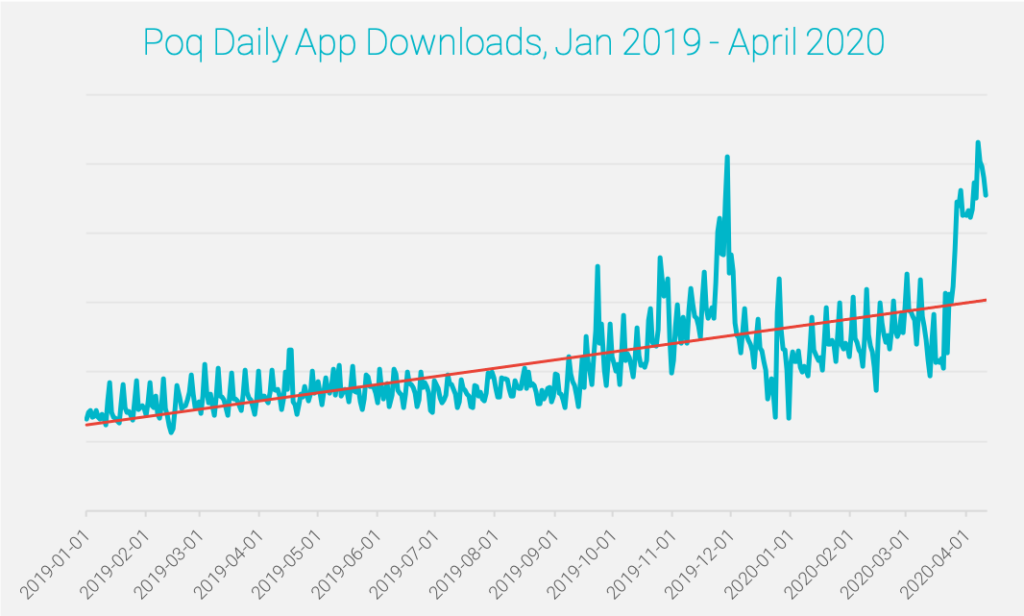App Commerce News – March 2020

The topic taking the news by storm lately is the global COVID-19 pandemic. With 25% of the world’s population now in lockdown and non-essential shops being forced to close in many affected countries, it’s no surprise that consumer behaviours are changing rapidly. But it’s not all doom and gloom…
What to expect in this article:
- Some Good News for Retail
- The Good Things Retailers Are Doing to Help During the COVID-19 Outbreak
- Useful Links for Tracking How Coronavirus is Affecting Retail
- Thinking App-First
- How Video Plays a More Important Role in Retail than Ever Before
Some Good News for Retail
As social distancing becomes the new norm and businesses take to working online and using video conferencing rather than meeting in person (you can see our weekly team meeting above), people are turning to the internet to pass the time. A lot of businesses are seeing increased traffic on websites and apps, from news apps to education and social networks to entertain themselves. We’ve found that this is the same situation for retail.

Update April 15th:
App downloads on April 7th & 8th overtook the highest daily download figures seen in 2019 – Black Friday.
App downloads during the last 2 weeks of March were at the same level as during the first weeks of November – when the peak sales season pick-up. This same pattern can be seen globally and also on a country by country basis. With more shoppers downloading apps we anticipate seeing them spend more time interacting with brands through this channel. According to App Annie the more time spent with apps correlates with a growth in app revenue.
When comparing ecommerce revenue to last year, sales figures are up for retailers by as much as 106% and up by 46% YoY for fashion apparel brands.
Learn how you can improve your app engagement and maintain your customer relationships during this unprecedented time. Watch the webinar now available on-demand.
The Good Things Retailers Are Doing to Help During the COVID-19 Outbreak
- H&M – have announced that it is repurposing its manufacturing to create Personal Protective Equipment (PPE) for front-line medical staff in Europe.
- Brewdog – Scottish founded brewery & Bacardi – the world’s largest privately held spirits company have both assigned a portion of their production line to make hand sanitizer. Brewdog is giving it away for free to charities and those who need it most!
- Nike – Made their exercise class app free for anyone to use and their digital sales are actually up 36%. By having an excellent app experience and going beyond its transactional functionality the sports brand has maintained great customer relationships during this time of social distancing.
- Caffé Nero, Costa, Starbucks & McDonalds – Were giving free hot drinks to NHS workers in the UK before having to close their stores due to stricter measures.
- BP – Are providing free fuel for emergency service vehicles.
- TK Maxx – Donated all remaining food in their stores to food banks.
Useful Links for Tracking How Coronavirus is Affecting Retail
- Retail Dive’s Retail Response to COVID-19 Tracker
- Internet Retailing’s Coronavirus Consumer Confidence Tracker
- NRF – Coronavirus Resources for Retailers
- YouGov –International COVID-19 Tracker
Thinking App-First
According to Forbes, Direct-to-Consumer (D2C) brands should be embracing an app-first strategy. D2C brands typically use social media as their main acquisition channels and because they sell directly to the consumer they have complete control and often have superior end-to-end shopping experiences.
In order to enhance the shopping experience Forbes argue that D2C brands should have an app-first approach because:
- Push notifications enable retailers to engage and retain users and improve the shopping journey through personalised push notifications.
- Shopping experience is crucial to D2C brands and this experience on apps is superior to both desktop and mobile-web.
- Apps open up the possibilities of features like Augmented Reality (AR) and in fact coronavirus has been an accelerator in the demand for AR by beauty brands.
In fact, shoppers have been turning to grocery apps in this time of social distancing. Walmart Grocery saw a 160% increase in average daily app downloads and Target saw a 96% increase in daily downloads over the last month as shoppers turn to online channels to complete their grocery shopping. And British online grocer Ocado, even had to temporarily suspend both its website and app due to the extraordinary surge in demand never seen before by the business.
Shopping apps, in general, are seeing continued demand from consumers. Global data from the Poq platform over the last month shows that user conversion rate (the unique users per month/transactions) is over 2x higher on apps than mobile web across all shopping verticals including Health & Beauty, Fashion and Shoes & Accessories.
Poq App vs Mobile Web User Conversion Rate
Video Plays a More Important Role in Retail than Ever Before
Video plays a crucial role in how Gen Z and Millennials consume media, half of Gen Z & Millennials ‘don’t know how they’d get through life‘ without video according to new research from Google. From product videos to inspirational content, video has become the most engaging form of visual storytelling. The influence of video becomes even more prominent with the expansion of 5G – which is now in 24 countries. 5G will facilitate the use of data-demanding functionalities like video and AR as more people have access to high-speed internet on the go.
Coronavirus has also driven a spike in usage of video-based social media platform, TikTok. The app is helping bring teens together in this time of social distancing as they share memes and videos of how they are coping with these changes.



